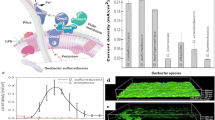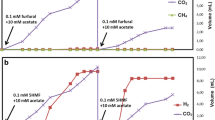Abstract
Microbial fuel cells (MFCs) have been shown to be capable of clean energy production through the oxidation of biodegradable organic waste using various bacterial species as biocatalysts. In this study we found Saccharomyces cerevisiae, previously known electrochemcially inactive or less active species, can be acclimated with an electron mediator thionine for electrogenic biofilm formation in MFC, and electricity production is improved with facilitation of electron transfer. Power generation of MFC was also significantly increased by thionine with both aerated and non-aerated cathode. With electrochemically active biofilm enriched with swine wastewater, MFC power increased more significantly by addition of thionine. The optimum mediator concentration was 500 mM of thionine with S. cerevisae in MFC with the maximum voltage and current generation in the microbial fuel cell were 420 mV and 700 mA/m2, respectively. Cyclic voltametry shows that thionine improves oxidizing and reducing capability in both pure culture and acclimated biofilm as compared to non-mediated cell. The results obtained indicated that thionine has great potential to enhance power generation from unmediated yeast or electrochemically active biofilm in MFC.
Similar content being viewed by others
References
Allen, R.M. and Bennetto, H.P. 1993. Microbial fuel cells: electricity production from carbohydrates. Appl. Biochem. Biotechnol. 39, 27–40.
Bennetto, H. 1990. Electricity generation by microorganisms. Biotechnology 1, 163–168.
Bennetto, H., Delaney, G., Mason, J., Roller, S., Stirling, J., and Thurston, C. 1985. The sucrose fuel cell: efficient biomass conversion using a microbial catalyst. Biotechnol. Lett. 7, 699–704.
Bennetto, H.P., Stirling, J.L., Tanaka, K., and Vega, C.A. 1983. Anodic reactions in microbial fuel cells. Biotechnol. Bioeng. 25, 559–568.
Beveridge, T.J. 2004. Composition, reactivity and regulation of extracellular metal-reducing structures (bacterial nanowires) produced by dissimilatory metal — reducing bacteria. Medium: ED.
Choi, Y., Kim, N., Kim, S., and Jung, S. 2003. Dynamic behaviors of redox mediators within the hydrophobic layers as an important factor for effective microbial fuel cell operation. Bull. Korean Chem. Soc. 24, 437–440.
Grzebyk, M. and Pozniak, G. 2005. Microbial fuel cells (MFCs) with interpolymer cation exchange membranes. Sep. Purif. Technol. 41, 321–328.
Gunawardena, A., Fernando, S., and To, F. 2008. Performance of a yeast-mediated biological fuel cell. Int. J. Mol. Sci. 9, 1893–1907.
Ieropoulos, I., Greenman, J., Melhuish, C., and Hart, J. 2005. Energy accumulation and improved performance in microbial fuel cells. J. Power Sources 145, 253–256.
Kim, J.R., Cheng, S., Oh, S.E., and Logan, B.E. 2007a. Power generation using different cation, anion and ultrafiltration membranes in microbial fuel cells. Environ. Sci. Technol. 41, 1004–1009.
Kim, J.R., Cheng, S., Oh, S.E., and Logan, B.E. 2007b. Power generation using different cation, anion, and ultrafiltration membranes in microbial fuel cells. Environ. Sci. Tech. 41, 1004–1009.
Kim, N., Choi, Y., Jung, S., and Kim, S. 2000. Effect of initial carbon sources on the performance of microbial fuel cells containing Proteus vulgaris. Biotechnol. Bioeng. 70, 109–114.
Kim, J.R., Min, B., and Logan, B.E. 2005. Evaluation of procedures to acclimate a microbial fuel cell for electricity production. Appl. Microbiol. Biotechnol. 68, 23–30.
Lee, S., Choi, Y., Jung, S., and Kim, S. 2002. Effect of initial carbon sources on the electrochemical detection of glucose by Gluconobacter oxydans. Bioelectrochem. 57, 173–178.
Liu, H., Cheng, S., and Logan, B.E. 2005. Power generation in fed-batch microbial fuel cells as a function of ionic strength, temperature, and reactor configuration. Environ. Sci. Technol. 39, 5488–5493.
Logan, B., Cheng, S., Watson, V., and Estadt, G. 2007. Graphite fiber brush anodes for increased power production in air-cathode microbial fuel cells. Environ. Sci. Technol. 41, 3341–3346.
Najafpour, G.D., Komeili, M., Tajallipour, M., and Asadi, M. 2010a. Bioconversion of cheese whey to methane in an upflow anaerobic packed bed bioreactor. Chem. Biochem. Engineer. Quarterly 24, 111–117.
Najafpour, G.D., Rahimnejad, M., Mokhtarian, N., Daud, W.R.W., and Ghoreyshi, A.A. 2010b. Bioconversion of whey to electrical energy in a biofuel cell using Saccharomyces cerevisiae. World Appl. Sci. J. 8, 01–05.
Oh, S.E., Kim, J.R., Joo, J., and Logan, B.E. 2009. Effects of applied voltages and dissolved oxygen on sustained power generation by microbial fuel cells. Water Sci. Technol. 60, 1311–1317.
Oh, S.T., Kim, J.R., Premier, G.C., Lee, T.H., Kim, C., and Sloan, W.T. 2010. Sustainable wastewater treatment: How might microbial fuel cells contribute. Biotechnol. Adv. 28, 871–881.
Oh, S. and Logan, B. 2005. Hydrogen and electricity production from a food processing wastewater using fermentation and microbial fuel cell technologies. Water Res. 39, 4673–4682.
Oh, S.E. and Logan, B.E. 2006. Proton exchange membrane and electrode surface areas as factors that affect power generation in microbial fuel cells. Appl. Microbiol. Biotechnol. 70, 162–169.
Oh, S.E., Min, B., and Logan, B.E. 2004. Cathode performance as a factor in electricity generation in microbial fuel cells. Environ. Sci. Technol. 38, 4900–4904.
Park, A.H., Kim, S.K., Shin, I.H., and Jeong, Y.J. 2000. Electricity production in biofuel cell using modified graphite felt electrode with neutral red. Biotechnol. Lett. 22, 1301–1304.
Park, D.H. and Zeikus, J.G. 1999. Utilization of electrically reduced neutral red by Actinobacillus succinogens: physiological function of nutral red in membrane driven fumrate reduction and energy conservation. J. Bacteriol. 181, 2403–2410.
Park, D.H. and Zeikus, J.G. 2000. Electricity generation in microbial fuel cells using neutral red as an electronophore. Appl. Environ. Microbiol. 66, 1292–1297.
Park, D.H. and Zeikus, J.G. 2003. Improved fuel cell and electrode designs for producing electricity from microbial degradation. Biotechnol. Bioeng. 81, 348–355.
Park, D.H. and Zeikus, J.G. 2002. Impact of electrode composition on electricity generation in a single-compartment fuel cell using Shewanella putrefaciens. Appl. Microbiol. Biotechnol. 59, 58–61.
Rabaey, K., Boon, N., Hofte, M., and Verstraete, W. 2005. Microbial phenazine production enhances electron transfer in biofuel cells. Environ. Sci. Technol. 39, 3401–3408.
Rabaey, K., Boon, N., Siciliano, S.D., Verhaege, M., and Verstraete, W. 2004. Biofuel cells select for microbial consortia that self-mediate electron transfer. Appl. Environ. Microbiol. 70, 5373–5382.
Reguera, G., McCarthy, K.D., Mehta, T., Nicoll, J.S., Tuominen, M.T., and Lovley, D.R. 2005. Extracellular electron transfer via microbial nanowires. Nature 435, 1098–1101.
Ringeisen, B.R., Henderson, E., Wu, P.K., Pietron, J., Ray, R., Little, B., Biffinger, J.C., and Jones-Meehan, J.M. 2006. High power density from a miniature microbial fuel cell using Shewanella oneidensis DSP10. Environ. Sci. Technol. 40, 2629–2634.
Schroder, U., Niessen, J., and Scholz, F. 2003. A generation of microbial fuel cells with current outputs boosted by more than one order of magnitude. Angew. Chem. Int. Ed. 42, 2880–2883.
Thurston, C., Bennetto, H., Delaney, G., Mason, J., Roller, S., and Stirling, J. 1985. Glucose metabolism in a microbial fuel cell. Stoichiometry of product formation in a thionine-mediated Proteus vulgaris fuel cell and its relation to coulombic yields. Microbiology 131, 1393.
Yoon, S.-M., Choi, C.-H., Kim, M., Hyun, M.-S., Shin, S.-H., Yi, D.-H., and Kim, H.J. 2007. Enrichment of electrochemically active bacteria using a three-electrode electrochemical cell. J. Microbiol. Biotechnol. 17, 110–115.
Author information
Authors and Affiliations
Corresponding authors
Rights and permissions
About this article
Cite this article
Rahimnejad, M., Najafpour, G.D., Ghoreyshi, A.A. et al. Thionine increases electricity generation from microbial fuel cell using Saccharomyces cerevisiae and exoelectrogenic mixed culture. J Microbiol. 50, 575–580 (2012). https://doi.org/10.1007/s12275-012-2135-0
Received:
Accepted:
Published:
Issue Date:
DOI: https://doi.org/10.1007/s12275-012-2135-0




